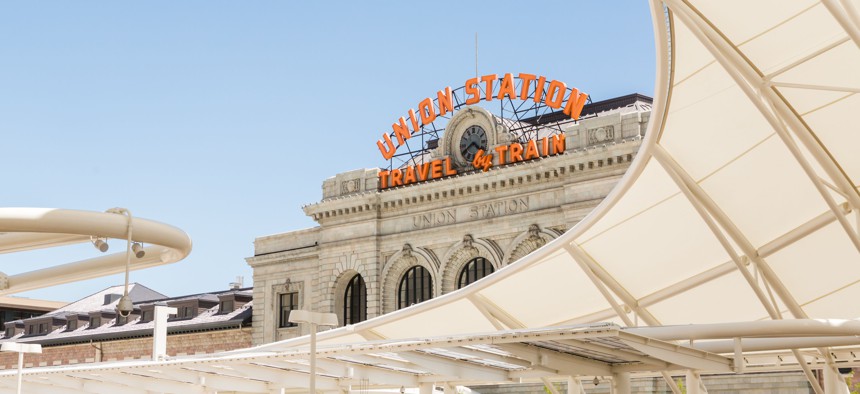Denver’s Game-Changing Airport Rail Line Is Nearly Ready

Denver Union Station Arina P Habich / Shutterstock.com
So far, relatively few trains have used Union Station’s expanded downtown rail hub. But that’s about to change in a big way in April.
DENVER — “Mommy, I want to see a train,” a toddler told her mother rather assertively on Sunday morning outside the passenger rail terminal at Union Station, which opened two years ago and still looks brand new.
That young child’s trainspotting pursuit at Denver’s new rail hub , which sits beneath 11 white steel-arched trusses spanning nearly 180 feet, is mostly pointless at the moment.
Colorado’s capital and largest city may have opened its renovated and expanded transit hub back in May 2014, but besides Amtrak’s daily California Zephyr service, there hasn’t yet been any other regular train service serving Union Station’s new passenger rail facility.
Crossing over the station complex on an elevated walkway on Sunday, the place was rather sleepy—and seemed a bit too clean to be a rail hub.
The multi-modal facility is anchored by the historic 102-year-old Beaux-Arts station structure, which has been repurposed as a sharp-looking high-end hotel , restaurant, bar and retail complex . The soaring Great Hall boasts mid-century modern couches, woven rugs and two shuffleboard tables. It’s an urban living room and a busy people-watching spot.

Next door, Union Station’s new rail terminal doesn’t quite feel like a fully functioning transportation hub yet. But the current relative calm along the platforms will soon change.
The A Line , the Regional Transit District’s electrified commuter 22.8 mile rail line connecting Union Station with Denver International Airport, will start carrying passengers on April 22 with service every 15 minutes from 6 a.m. to 8 p.m. with 30-minute service in off-peak periods.
Colorado tourism and economic development officials have been anticipating the airport rail service as a major selling point to draw conventions and visitors who have been inconvenienced by the long, often traffic-clogged drive into Denver from DIA’s rather isolated location northeast of the city. (Denver tourism promotions on my local public radio station in Washington, D.C., WAMU-FM, have touted the airport rail convenience factor.)
The 37-minute A Line rail trip between DIA and Union Station will be $9. (My flat-rate taxi cost in from the airport early Sunday morning was $55. Depending on traffic conditions on Interstate 70, that trip can take more than hour during peak periods.)
Additional commuter rail service at Union Station scheduled to start service in 2016 includes RTD’s B Line to Westminster (and eventually, to Boulder and Longmont) and G Line to Arvada and Wheat Ridge.
Article continues below ...

After years of planning and construction, some of the most important pieces of Denver’s expanding regional transit network are falling into place, thanks to the 2004 voter-approved FasTracks measure that authorized 122 miles of new light rail and commuter rail lines.
Union Station, located in Denver’s revitalized Lower Downtown neighborhood, is the regional rail network’s hub and is surrounded by new residential and commercial developments, sports facilities and revitalized warehouses on the edge of the central business district.

The workhorse of the new Union Station is the underground, 22-gate bus concourse , which connects the historic station building, the new train station’s platforms, RTD’s light-rail station for the C, E and W lines and the free 16th Street Mall bus line to the Civic Center, which sits at the other end of Denver’s central business district.
The enclosed concourse stretches the length of three football fields and is illuminated by large skylights—it’s very different from what you’d normally imagine for an underground transit complex, like the long gloomy Penn Station in New York City.
During peak periods, buses are leaving the underground concourse every 48 seconds to destinations locally, regionally and in other states. Soon commuter trains to the airport and neighboring cities will be entering and leaving the station one level up.
The revitalized and expanded Union Station that has taken shape in Denver has been in the works for years. And 2016 is the year when so much of that earlier transportation vision all comes together.
Michael Grass is Executive Editor of Government Executive’s Route Fifty.
NEXT STORY: State and Local Weekend Digest: Hawaii’s Girl Scout Cookie Tax; Ala. Prison Riot Video






